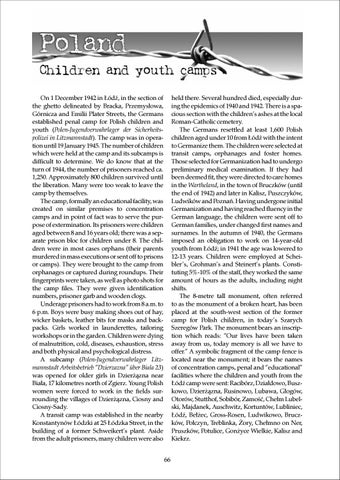Poland Children and youth camps On 1 December 1942 in Łódź, in the section of the ghetto delineated by Bracka, Przemysłowa, Górnicza and Emilii Plater Streets, the Germans established penal camp for Polish children and youth (Polen-Jugendverwahrlager der Sicherheitspolizei in Litzmannstadt). The camp was in operation until 19 January 1945. The number of children which were held at the camp and its subcamps is difficult to determine. We do know that at the turn of 1944, the number of prisoners reached ca. 1,250. Approximately 800 children survived until the liberation. Many were too weak to leave the camp by themselves. The camp, formally an educational facility, was created on similar premises to concentration camps and in point of fact was to serve the purpose of extermination. Its prisoners were children aged between 8 and 16 years old; there was a separate prison bloc for children under 8. The children were in most cases orphans (their parents murdered in mass executions or sent off to prisons or camps). They were brought to the camp from orphanages or captured during roundups. Their fingerprints were taken, as well as photo shots for the camp files. They were given identification numbers, prisoner garb and wooden clogs. Underage prisoners had to work from 8 a.m. to 6 p.m. Boys were busy making shoes out of hay, wicker baskets, leather bits for masks and backpacks. Girls worked in launderettes, tailoring workshops or in the garden. Children were dying of malnutrition, cold, diseases, exhaustion, stress and both physical and psychological distress. A subcamp (Polen-Jugendverwahrlager Litzmannstadt Arbeitsbetrieb “Dzierzazna” über Biala 23) was opened for older girls in Dzierżązna near Biała, 17 kilometres north of Zgierz. Young Polish women were forced to work in the fields surrounding the villages of Dzierżązna, Ciosny and Ciosny-Sady. A transit camp was established in the nearby Konstantynów Łódzki at 25 Łódzka Street, in the building of a former Schweikert’s plant. Aside from the adult prisoners, many children were also
held there. Several hundred died, especially during the epidemics of 1940 and 1942. There is a spacious section with the children’s ashes at the local Roman-Catholic cemetery. The Germans resettled at least 1,600 Polish children aged under 10 from Łódź with the intent to Germanize them. The children were selected at transit camps, orphanages and foster homes. Those selected for Germanization had to undergo preliminary medical examination. If they had been deemed fit, they were directed to care homes in the Wartheland, in the town of Bruczków (until the end of 1942) and later in Kalisz, Puszczyków, Ludwików and Poznań. Having undergone initial Germanization and having reached fluency in the German language, the children were sent off to German families, under changed first names and surnames. In the autumn of 1940, the Germans imposed an obligation to work on 14-year-old youth from Łódź; in 1941 the age was lowered to 12-13 years. Children were employed at Scheibler’s, Grohman’s and Steinert’s plants. Constituting 5%-10% of the staff, they worked the same amount of hours as the adults, including night shifts. The 8-metre tall monument, often referred to as the monument of a broken heart, has been placed at the south-west section of the former camp for Polish children, in today’s Szarych Szeregów Park. The monument bears an inscription which reads: “Our lives have been taken away from us, today memory is all we have to offer.” A symbolic fragment of the camp fence is located near the monument; it bears the names of concentration camps, penal and “educational” facilities where the children and youth from the Łódź camp were sent: Racibórz, Działdowo, Buszkowo, Dzierżązna, Rusinowo, Lubawa, Głogów, Otorów, Stutthof, Sobibór, Zamość, Chełm Lubelski, Majdanek, Auschwitz, Kortuntów, Lubliniec, Łódź, Bełżec, Gross-Rosen, Ludwikowo, Bruczków, Połczyn, Treblinka, Żory, Chełmno on Ner, Pruszków, Potulice, Gonżyce Wielkie, Kalisz and Kiekrz. 66
